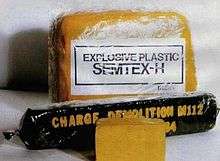Semtex
Semtex is a general-purpose plastic explosive containing RDX and PETN.[1] It is used in commercial blasting, demolition, and in certain military applications.

Semtex was developed and manufactured in Czechoslovakia, originally under the name B 1 and then under the "Semtex" designation since 1964,[note 1] labeled as SEMTEX 1A, since 1967 as SEMTEX H, and since 1987 as SEMTEX 10.
Originally developed for Czechoslovak military use and export, Semtex eventually became popular with paramilitary groups and rebels or terrorists because prior to 2000 it was extremely difficult to detect,[3] as in the case of Pan Am Flight 103.
Composition
The composition of the two most common variants differ according to their use. The 1A (or 10) variant is used for mining, and is based mostly on crystalline PETN. The versions 1AP and 2P are formed as hexagonal booster charges; a special assembly of PETN and wax inside the charge assures high reliability for detonating cord or detonator. The H (or SE) variant is intended for explosion hardening.[4]
| Compound | Semtex 1A | Semtex H | Semtex 2P |
|---|---|---|---|
| PETN | 76% | 40.9% | 58.45% |
| RDX | 4.6% | 41.2% | 22.9% |
| binder: styrene-butadiene | 9.4% | 9% | 9.2% |
| plasticizers: n-octyl phthalate, tributyl citrate | 9% | 7.9% | 8.45% |
| antioxidant: N-phenyl-2-naphthylamine | 0.5% | 0.5% | 0.5% |
| pigment | 0.5% Sudan IV (reddish brown to red) | 0.5% Sudan I (red-orange to yellow) | variable |
History
Semtex was invented in the late 1950s by Stanislav Brebera and Radim Fukátko, chemists at VCHZ Synthesia, Czechoslovakia (now Czech Republic). The explosive is named after Semtín, a suburb of Pardubice where the mixture was first manufactured starting in 1964.[2] The plant was later renamed to become Explosia a.s., a subsidiary of Synthesia.[5]
Semtex was very similar to other plastic explosives, especially C-4, in being highly malleable; but it is usable over a greater temperature range than other plastic explosives, since it stays plastic between −40 and +60 °C. It is also waterproof. There are visual differences between Semtex and other plastic explosives, too: while C-4 is off-white in colour, Semtex is red or brick-orange.
The new explosive was widely exported, notably to the government of North Vietnam, which received 14 tons during the Vietnam War. However, the main consumer was Libya; about 700 tons of Semtex were exported to Libya between 1975 and 1981 by Omnipol. It has also been used by Islamic militants in the Middle East and by the Provisional Irish Republican Army (PIRA) and the Irish National Liberation Army in Northern Ireland.[6]
Sales declined after Semtex became closely associated with terrorist attacks. Rules governing the explosive's exportation were progressively tightened over the years, and since 2002 all of Explosia's trading has been controlled by a government ministry.[7] As of 2001, only approximately 10 tons of Semtex were produced annually, almost all for domestic use.[2] On December 21, 1988, 12 ounces (340g) of Semtex brought down a Boeing 747 over Lockerbie, Scotland killing all 259 passengers and crew aboard the aircraft and 11 bystanders on the ground.
Also in response to international agreements, Semtex has a detection taggant added to produce a distinctive vapor signature to aid detection. First, ethylene glycol dinitrate was used, but was later switched to 2,3-dimethyl-2,3-dinitrobutane (DMDNB) or p-mononitrotoluene (1-methyl-4-nitrobenzene), which is used currently. According to the manufacturer, the taggant agent was voluntarily being added by 1991, years before the protocol became compulsory.[2] Batches of Semtex made before 1990, however, are untagged, though it is not known whether there are still major stocks of such old batches of Semtex. According to the manufacturer, even this untagged Semtex can now be detected.[8] The shelf life of Semtex was reduced from ten years before the 1990s to five years now. Explosia states that there is no compulsory tagging allowing reliable post-detonation detection of a certain plastic explosive (such as incorporating a unique metallic code into the mass of the explosive), so Semtex is not tagged in this way.[9]
On 25 May 1997, Bohumil Šole, a scientist who claimed to have been involved with inventing Semtex, committed suicide at a spa in Jeseník by blowing himself up with explosives. Šole, 63, was being treated there for psychological problems. It was unclear what explosives were used. Twenty other people were hurt in the explosion, while six were seriously injured. According to the manufacturer, Explosia, he was not a member of the team that developed the explosive in the 1960s.[10][11]
According to the producer's 2017 catalog, several variants of Semtex are offered: Semtex 1A, Semtex 1H, Semtex 10, Semtex 10-SE, Semtex S 30, Semtex C-4, Semtex PW 4, and Semtex 90.[12]
Notes
- Various sources state that production started in 1964 or 1966. Explosia's brief historical document states it was 1964,[2] but most other credible sources state it was in 1966. Most of these also state that development was started at the same time, in response to a request from Vietnam for a counterpart to the United States construction of C-4.
References
- Pike, John. "Explosives - Compounds". www.globalsecurity.org. Retrieved 7 December 2017.
- "Explosia". www.explosia.cz. Retrieved 7 December 2017.
- Schubert, Hiltmar. Detection of Explosives and Landmines: Methods and Field Experience. pp. 93–101 ISBN 1-4020-0692-6
- http://www.mondial-defence.com/images/PDF_Data_Sheets/SEMTEX.pdf "Semtex" Check
|archive-url=value (help) (PDF). Explosives. Mondial Defence Systems. Archived from the original (PDF) on 5 October 2013. Retrieved 2012-11-26. - "Explosia". www.explosia.cz. Retrieved 7 December 2017.
- Brown, G. I. (1998). The Big Bang: A History of Explosives. Sutton Publishing. ISBN 0-7509-1878-0. p. 165.
- Arie Farnam, "Czechs try to cap plastic explosives sales", Christian Science Monitor, 26 February 2002
- "Explosia". www.explosia.cz. Retrieved 7 December 2017.
- "Explosia". www.explosia.cz. Retrieved 7 December 2017.
- "Bohumil Sole dies". The Washington Post. 1997-06-04. Retrieved 2019-01-02.
- "Semtex — 10 Mistakes – Explosia". explosia.cz. Retrieved 2019-01-01.
- https://explosia.cz/app/uploads/2017/11/Explosives-catalog-2017.pdf